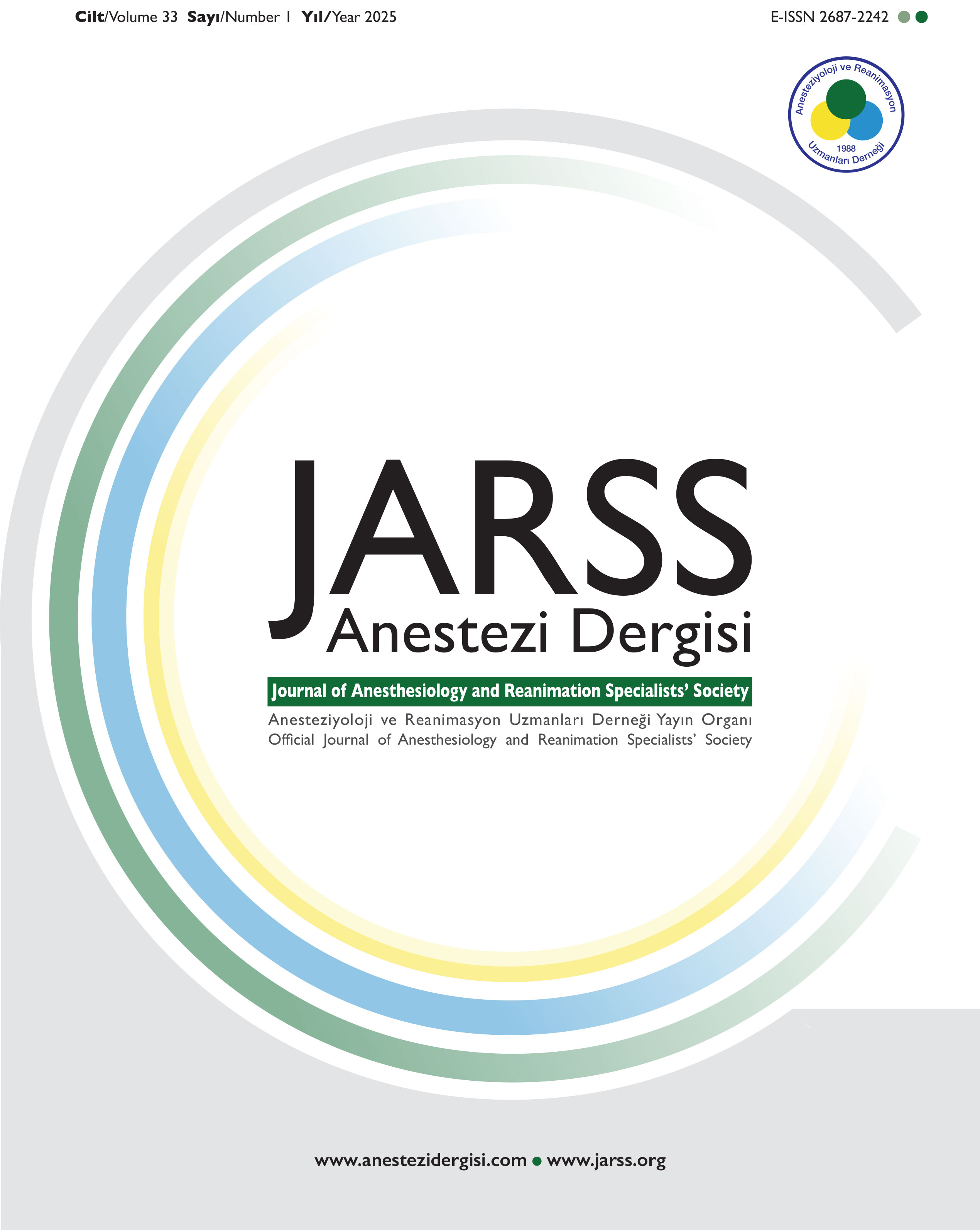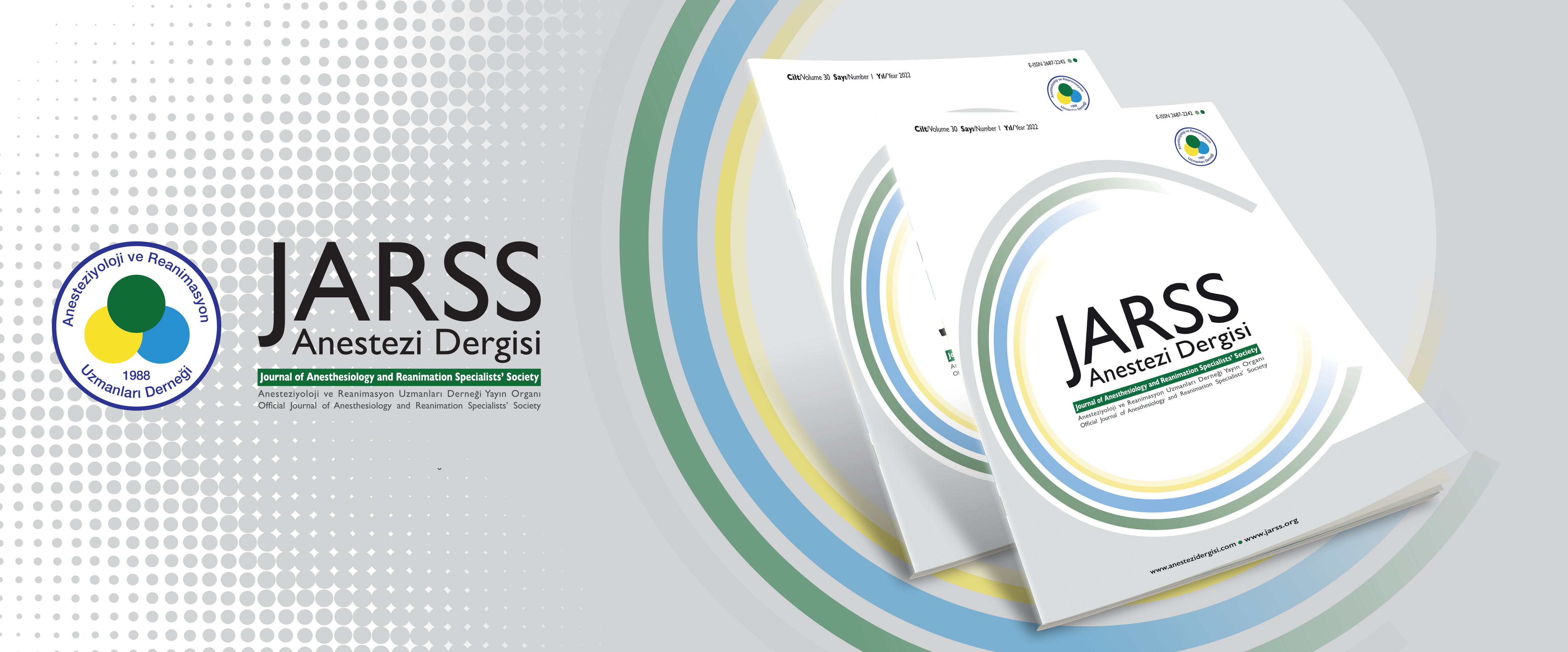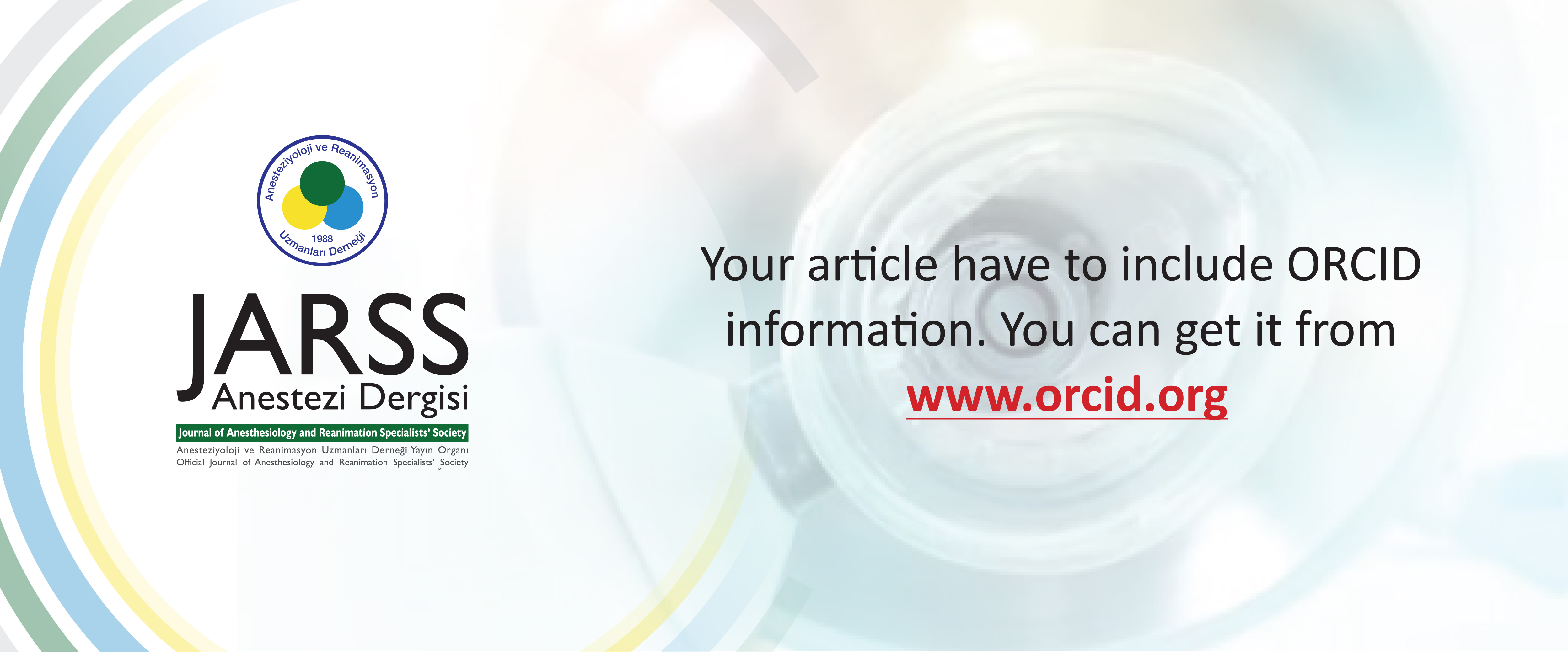Volume: 31 Issue: 3 - 2023
| 1. | Cover Pages I - 0 (358 accesses) |
| 2. | Advisory Board Pages II - IV (323 accesses) |
| 3. | Contents Pages V - VI (349 accesses) |
| REVIEW | |
| 4. | Laparoscopic Surgery and Anesthesia Begum Nemika Gokdemir, Nedim Cekmen doi: 10.54875/jarss.2023.63496 Pages 173 - 187 (1658 accesses) Laparoscopic surgery (LS) is superior to conventional laparotomy due to its advantages, such as less trauma, early mobilization, minimal blood loss, less scarring, reduced postoperative pain, shorter postoperative recovery time and hospital stay, and lower mortality and morbidity. Significant hemodynamic, cardiopulmonary, and physiological changes occur in the systems due to increased intra-abdominal pressure and hypercarbia after carbon dioxide insufflation is applied for pneumoperitoneum (PP) during LS. The main goals in anesthesia management are understanding the primary pathophysiology, optimizing functional status and hemodynamics, and managing comorbidities. To minimize the effects and impacts of PP in patients who will undergo LS, as in every patient, comprehensive preoperative evaluation should be carried out by multidisciplinary approach that includes an anesthesiologist and surgeon. Our review emphasizes the importance of pathophysiological and systemic changes during LS performed by applying PP and summarizes the recovery and postoperative complications of anesthesia methods applied in clinical practice. |
| ORIGINAL RESEARCH | |
| 5. | Comparison of Sevoflurane Inhalation Anesthesia and Total Intravenous Anesthesia with Propofol in Terms of Postoperative Sore Throat and Nausea/Vomiting in Septorhinoplasty Cases Meral Erdal Erbatur, Andac Dedeoglu, Okan Andic, Resit Saruhan, Recep Gokce, Osman Uzundere, Erhan Gokcek, Cem Kivilcim Kacar doi: 10.54875/jarss.2023.26879 Pages 188 - 196 (943 accesses) Objective: The objective of this prospective observational study was to compare the use of inhalation anesthesia with sevoflurane and total intravenous anesthesia with propofol in terms of sore throat and postoperative nausea/vomiting in elective septorhinoplasty cases under general anesthesia. Methods: This study was conducted using the data of 52 participating patients. Following induction of anesthesia, Group 1 (n=26) received sevoflurane inhalation and remifentanil infusion, while Group 2 (n=26) received intravenous propofol and remifentanil infusion. The presence of nausea/vomiting, the presence and severity of sore throat, extubation times, and the number of patients who were given additional analgesics and antiemetics were recorded at the end of operation. Results: Within post-anesthesia care unit, Group 2 had less sore throat at the postoperative 2nd, 6th, and 12th h (p values, respectively: 0,014; 0,004; 0,015; 0,044. The number of patients receiving additional analgesics in the postoperative period was 19 in Group 1 and 9 in Group 2 (p=0.005). The results of the groups in terms of postoperative nausea/vomiting were similar. Conclusion: In septorhinoplasty operations, total intravenous anesthesia with propofol resulted in less sore throat and reduced postoperative analgesic use compared to inhalation anesthesia with sevoflurane. |
| 6. | The Impact of Hematological Parameters on Pain Relief After Transforaminal Epidural Steroid Injection Samet Sancar Kaya doi: 10.54875/jarss.2023.57614 Pages 197 - 202 (379 accesses) Objective: Since inflammation plays an important role in radiculopathies, and that neutrophil/lymphocyte ratio (NLR) and platelet/lymphocyte ratios (PLR) are known to be associated with inflammation, the effects of these values on transforaminal epidural steroid injections (TFESI) in patients with lumbar radiculopathy were investigated. Methods: A total of 101 patients, who were diagnosed with lumbar radiculopathy and underwent TFESI, were retrospectively analyzed. Therapeutic success was considered to be a ≥ 50% decrease in visual analog scale (VAS) scores one month after TFESI. The patients in the study were placed in two groups according to whether their treatment was successful or unsuccessful, according to this criteria, and hemogram parameters in the two groups were then compared. Results: The study included 46 female and 55 male patients with a mean age of 49.43 ± 13.29. The median duration of symptoms was 3.0 (3.0-8.0) months. It was found that there was no significant difference between the groups in terms of neutrophil, lymphocyte, monocyte, platelet counts, mean plazma volümü (MPV), kırmızı hücre dağılım genişliği (RDW), platelet/ lenfosit oranı (PLR), sistemik inflamatuar indeks (SII), sedimentation, and C-reactive protein (CRP), although it was observed that there were significant increases in NLR in the successful group [2.34 (1.70-3.17)], as compared to the unsuccessful group [1.79 (1.51-2.57)] (p=0.026). Conclusion: Neutrophil/lymphocyte ratio is able to predict the response to TFESI treatment in patients with lumbar radiculopathy, in that patients with a higher NLR demonstrate a better response. |
| 7. | Comparison of Epidural Catheter Migration in Three Different Techniques of Catheter Fixation: A Prospective Randomised Study Vidarshna Viburajah, Venkatesh Selvaraj, Sree Kumar E J, Sathish Kalyan doi: 10.54875/jarss.2023.59480 Pages 203 - 209 (411 accesses) Objective: We hypothesized that subcutaneous tunnelling will be more efficacious in preventing epidural catheter migration in the postoperative period. To compare three different fixation techniques for migration of epidural catheter in the postoperative period. Methods: Patients undergoing elective surgery with planned postoperative analgesia with lumbar epidural were included. They were divided into 3 groups based on catheter fixation – Group I: transparent adhesive dressing tape, Group II: fixator device (Locklt Plus®) and Group III: catheter subcutaneously tunnelled vertically. The catheter mark was noted during insertion and on removal at the end of second day. The primary outcome measure was epidural catheter migration; the secondary outcome measures were complications and patient satisfaction scores. Results: Of the 170 patients recruited, 150 patients were included. The Likelihood Ratio (LR) of migration of group I in comparison to group II was 13.28 (p<0.001) while with group III was 7.06 (p=0.007). There was no significant difference between groups II and III (LR 1.12, p=0.29). The satisfaction scores were comparable among Groups II and III. There was no difference in complications among groups. Conclusion: Epidural migration is significantly reduced by both tunnelling and Lockit plus® methods in comparison to a transparent adhesive dressing in patients on continuous lumbar epidural analgesia in the first two postoperative days. The subcutaneous tunnelling method is as safe in terms of migration as the LockIt plus® method of fixation. |
| 8. | Effect of Serum Uric Acid Level on Severity of Respiratory Failure and Mortality in COVID-19 Critical Patients Ümmügülsüm Gaygısız, Lale Karabıyık doi: 10.54875/jarss.2023.75508 Pages 210 - 216 (367 accesses) Objective: Routine laboratory parameters such as C-reactive protein (CRP), procalcitonin, ferritin, d-dimer are used to estimate the clinical severity and mortality of Coronavirus disease 2019 (COVID-19). Because of the limited specificity of these parameters and their variability between patients, more specific parameters are needed. It is thought that there may be a relationship between uric acid levels and the severity and mortality of COVID-19. In this study, we aimed to retrospectively investigate the relationship between daily serum uric acid measurements in the first 10 days of follow-up in the intensive care unit (ICU) and the need for invasive mechanical ventilation (IMV) and mortality. Methods: With the approval of the ethics committee, 151 eligible patients were screened through the ICU patient records and routine laboratory data on the computer. Serum uric acid measurements, demographic and clinical characteristics, IMV needs and mortality rates at the first admission to the hospital and in the first 10 days in the ICU were recorded retrospectively. Results: In the analysis, rate of IMV was 60.3% and mortality was 53.6%. No significant correlation was found between the uric acid levels measured at the time of first hospitalization and in the ICU follow-up and the need for IMV. In the comparison between deceased and survived patient groups; the uric acid levels were found to be higher on the 3rd and 4th days of the ICU in the deceased group than in the survivors (p=0.023, p=0.037, respectively). Conclusion: The increase in uric acid levels on the 3rd and 4th days in COVID-19 patients requiring ICU admission seems to be significant in the estimation of mortality. Serum uric acid level can be a useful parameter in determining the prognosis in the ICU follow-up of this group patients. |
| 9. | Comparision of Ketofol and Midazolam-Fentanyl Sedoanalgesia Methods in Septoplasty Operations Bilge Olgun Keleş, Menşure Kaya, Serpil Şavlı, Fatih Arslan, Cemile Açıkgöz Yıldız, Elvan Tekir Yılmaz doi: 10.54875/jarss.2023.35693 Pages 217 - 221 (387 accesses) Objective: Sedoanalgesia is an anesthesia method that is preferred mostly in outside the operating room interventions and some short-term surgeries, allowing the procedure to be performed by using sedative and dissociative agents alone or together. Closed technique septoplasty operation is also an operation that can be performed with sedoanalgesia. The aim of this study is to compare the sedative and analgesic effects of ketamine and propofol combination and midazolam and fentanyl combination, surgical satisfaction and patient satisfaction in patients who underwent closed technique septoplasty operation. Methods: After ethics committee approval, 60 ASA I and II patients were included in the study by dividing into 2 groups. Patients who used ketamine and propofol for sedoanalgesia were named Group 1 (ketofol), and patients who used midazolam and fentanyl were named Group 2 (midafenta). The data of the patients were recorded from the intraoperative anesthesia forms and the postoperative recovery unit forms. Complications, side effects, surgery and patient satisfaction were questioned. Results: Mean arterial pressure was found to be significantly lower in the ketofol group at the 3rd minute after induction than in the midfenta group. The sedation score in the midafenta group at the 10th and 20th minutes intraoperatively was significantly lower than in the ketofol group. There was no significant difference in patient satisfaction, but surgical satisfaction was significantly higher in the midafenta group. Conclusion: In closed technique septoplasty operations, sedoanalgesia applied with ketofol and midafenta methods can be used without the need for general anesthesia. However, ketofol, which is highly preferred for sedoanalgesia, did not provide sufficient surgical satisfaction in patients who underwent closed technique septoplasty. We attributed this to the dissociation of the patients and their inability to comply with surgical commands. |
| 10. | The Effect of Spinal and General Anesthesia on Thiol-Disulfide Balance During Ischemia/Reperfusion of the Leg in Patients Undergoing Knee Replacement Surgery Esma Meltem Simsek, Semsi Mustafa Aksoy, Nurettin Manti, Ozcan Erel, Salim Neselioglu, Ahmet Firat doi: 10.54875/jarss.2023.35492 Pages 222 - 229 (531 accesses) Objective: Surgical trauma causes serious neuroendocrine and cytokine activity. In addition, the free oxygen radicals formed because of the ischemia/reperfusion injury resulting from applying and releasing the tourniquet (TQ) cause oxidative stress. Thiol and disulfide are among the new oxidative stress parameters used reliably in recent years. The aim of this study was to compare thiol-disulfide balance in general and spinal anesthesia, which are frequently used in total knee replacement (TKR) surgery. Methods: Fifty six patients aged 60-74 years scheduled to undergo TKR were randomly allocated to the general anesthesia (n=26) and spinal anesthesia (n=30) groups. The tourniquet (TQ) was applied for the TKR procedure after collecting a preanesthetic blood sample (T1). Blood samples were also collected at 5 minutes (T2) and 40 minutes (T3) after TQ release and at postoperative 24 hours (T4) to analyze native thiol, total thiol, disulfide, disulfide/native thiol ratio, disulfide/total thiol ratio, and native thiol/total thiol ratio. All patients had intravenous patient-controlled analgesia during the postoperative period. Mean arterial pressure, TQ times, and Visual Analogue Scale (VAS) scores were recorded. Decrease in thiol and increase in disulfide in the thiol-disulfide balance were recorded as oxidative stress indicators. Results: There was no difference between the groups in terms of VAS and analgesic consumption at the end of 24 hours. The general anesthesia group had higher native thiol, total thiol, and native thiol/total thiol ratio and lower disulfide, disulfide/native thiol ratio, and disulfide/total thiol ratio at all time points compared to the spinal anesthesia group. Conclusion: Assessment in terms of thiol-disulfide balance suggests that general anesthesia had a favorable effect on oxidative stress. |
| 11. | Prognostic Markers in COVID-19 Patients in Intensive Care: Can Hemostatic Parameters Predict Mortality? Duygu Kayar Çalılı, Ali Yasin Özercan, Halil Demirçakan, Selman Ünal, Serdar Başboğa, Yılmaz Aslan, Deniz Erdem, Demet Bölükbaşı, Seval İzdeş doi: 10.54875/jarss.2023.55822 Pages 230 - 238 (322 accesses) Objective: Our study aimed to investigate whether primarily hemostasis parameters and secondarily demographic, clinical, and laboratory values could predict the mortality of critically ill Coronavirus Disease 2019 (COVID-19) patients. Methods: We retrospectively examined 180 laboratory-confirmed adult intensive care unit (ICU) patients with COVID-19. A total of 145 patients with complete records were included in the study. The patients were divided into two groups: deceased (n=58) and discharged (n=87). The demographic and clinical characteristics of the two groups, use of vasopressor therapy, requirement for invasive mechanical ventilation (IMV), Acute Physiology and Chronic Health Evaluation II (APACHE II) score, duration of ICU stay, and the relationship between laboratory values on ICU admission and mortality were evaluated using cutoff values. Results: Among hemostatic parameters, only D-dimer>1.08 mg L⁻¹ was found to be a significant predictor of mortality (p=0.04), while platelet, prothrombin time (PT), activated partial thromboplastin time (aPTT), International Normalized Ratio (INR) and fibrinogen values were not significantly associated with mortality (p>0.05). In addition, age >76 years, hypertension (HT), need for IMV, APACHE II score >23, procalcitonin (PCT) >0.21 μg L⁻¹, lymphocytes <0.4 109 L⁻¹, interleukin 6 (IL-6) >93 pg mL⁻¹ were found to be predictors of mortality (p<0.05). Neutrophil and C-reactive protein (CRP) values were not significantly associated with mortality (p>0.05). Conclusion: Our study determined that advanced age, HT, high APACHE II score, requirement for IMV, vasopressor therapy, PCT, lymphocyte count, IL-6, and D-dimer levels could serve as predictors of mortality. Identifying predictors of mortality in COVID-19 is valuable for early recognition of disease progression and management of potential complications. |
| 12. | Approaches of Neurosurgeons and Orthopedists to the Protocol for Enhanced Recovery After Surgery (ERAS) in Spinal Pathologies: A Single Center, Survey Study Gokcen Emmez doi: 10.54875/jarss.2023.96729 Pages 239 - 248 (418 accesses) Objective: The Enhanced Recovery After Surgery (ERAS) protocol defines multimodal interventions applied to patients during the postoperative period to enable them to return to their normal life functions as quickly as possible. It encompasses the perioperative process from the patient’s hospital admission to discharge. The aim of our study is to observe the approaches of neurosurgeons and orthopedists at our center regarding the ERAS protocol in spinal pathologies and create awareness to ensure the routine implementation of ERAS. Methods: The survey, organized according to the items of the ERAS protocol for spinal surgeries, was delivered to the participants in person or via email after obtaining approval from the local ethics committee. The survey consisted of questions aimed at investigating the approaches of surgeons regarding fundamental aspects such as anesthesia, analgesia, surgical approach, fasting-nutrition, and early mobilization during the preoperative, intraoperative, and postoperative periods of spinal surgery. Results: The survey was completed by 53 doctors, with 22 (41.5%) being neurosurgeons and 31 (58.5%) orthopedists. When evaluating the responses of the participants to the questions related to the preoperative period, it was found that patient education, blood glucose regulation for diabetic patients, preoperative skin preparation, and the use of prophylactic antibiotics and antithrombotic agents were all implemented at a rate of 100%. Regarding the choice of anesthesia method, it is noteworthy that 38.7% of orthopedists preferred regional anesthesia, while 59% of neurosurgeons opted for general anesthesia. In terms of postoperative care, the surgical teams showed a preference for removing surgical drains and urinary catheters on the first day after the surgery. As for early mobilization, 87.1% of orthopedists preferred the first postoperative day, whereas 72.7% of neurosurgeons chose the day of surgery for mobilization. Conclusion: The clinics that participated in the survey demonstrated practices that were either closely aligned or suitable to the elements constituting the ERAS protocol, even if these practices were not explicitly categorized under the ERAS heading. To ensure the widespread and accurate adoption of ERAS protocols in clinical settings, it is essential to provide the surgical teams with adequate information and encourage them to utilize ERAS principles. |
| CASE REPORT | |
| 13. | Combined Therapy in Severe Valproic Acid Intoxication Fatma Erseven doi: 10.54875/jarss.2023.21704 Pages 249 - 251 (706 accesses) Valproic acid is frequently given to individuals who suffer from a variety of psychological and neurological conditions, including bipolar disorder, manic-depressive psychosis, major depressive disorder, post-traumatic stress disorder, and epilepsy. Because of its narrow therapeutic spectrum, it is one of agents that frequently cause toxicological emergencies. This case presents an adult patient who had valproic acid overdose, required intubation, hemodialysis, and concurrent treatment with carbapenem group antibiotics. |

















